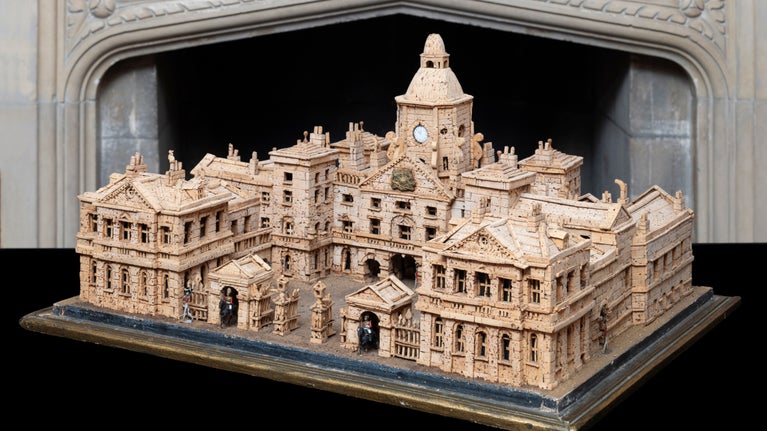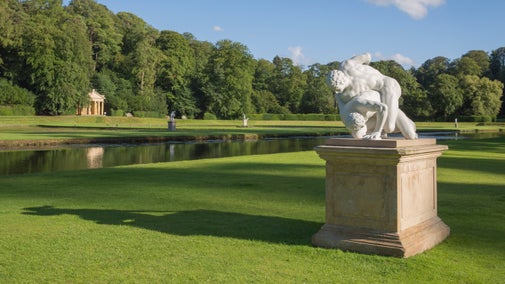
Art and collections
We care for one of the world's largest and most significant collections of art and heritage objects. Explore the highlights, our latest major exhibitions, curatorial research and more.

Many of the places in our care have collection items which have been inspired by the emotional highs and lows of love. From paintings to ceramics and sculptures, find out more about the art and objects that have connections to romance.
Throughout history, artists and designers have been drawn to all areas of the romantic world – the tales of doomed lovers, the unrequited passion and the uplifting romances of true love are reflected in so many artworks, including a number from the collections we look after.
Legend has it that a silver, heart-shaped locket at Moseley Old Hall in Staffordshire was a present from Charles II to one of his mistresses. Dating to around 1660, the locket contains a portrait of the king and is engraved with the words, ‘Cvpid's dart posses yovr hart’.
An anthology of Italian poetry at Sissinghurst Castle Garden in Kent was a gift to Vita Sackville-West from her mother, Victoria in 1911. The ornate leather binding features heart decorations and inside there is a heart-shaped leather label with an inscription from mother to daughter. It's one of several beautifully bound books given to Vita by her mother.
A colourful mosaic of intricately arranged seashells at Basildon Park in Berkshire is a charming example of a sailor's valentine. Made primarily by women in Barbados in the 19th century, these souvenirs were sold to British and American sailors as last-minute mementoes to take home after long journeys at sea.
Romanticism was an artistic and intellectual movement of the late 18th and early 19th centuries that shifted away from the Enlightenment’s focus on reason and instead emphasised the importance of emotion and imagination. In Romantic art, nature, with its uncontrollable power, unpredictability, and potential for cataclysmic extremes offered an alternative to the ordered world of Enlightenment thought.
Storm and Avalanche by Philip James de Loutherbourg at Petworth House in West Sussex embodies this approach. It depicts a fast-moving avalanche and captures the vulnerability of humans caught in the throes of nature.

Known as the isolated baronet, Sir Harry Harpur of Calke Abbey in Derbyshire was painfully shy, shutting himself off from society and even giving his servants orders by letter. He found happiness in 1792, marrying Nanette Hawkins, but as she was a lady’s maid and not a member of the aristocracy the marriage caused a scandal. A watercolour of Nanette is in the collection at Calke Abbey.

When Italian dancer Giovanna Zanerini, nicknamed La Baccelli, became lover to John Frederick Sackville, the third Duke of Dorset, he had a life-size plaster statue made of her. After the pair separated and John married, the statue was discretely moved to a less prominent position at Knole in Kent, and rechristened A Naked Venus.

We care for one of the world's largest and most significant collections of art and heritage objects. Explore the highlights, our latest major exhibitions, curatorial research and more.
From 18th-century mini palaces to entire model villages, discover the rare and exquisite dolls’ houses in the collections we care for.

Learn how the Romantic movement, led by poets and artists such as Byron and J.M.W. Turner, broke with the Enlightenment’s teachings to celebrate imagination and emotional sensitivity.

Taking part in sports is a popular pastime all over the world. From the origins of the Olympics to the evolution of cricket, discover sports through the ages at the collections and places we look after.

From goldwork and gilding to goldsmithing and jewellery making, discover the ways in which gold has been used in the objects in our collections.

We look after the largest collection of tapestries in the UK and one of the largest in the world. Learn more about these status symbols and explore some of the best examples of this craftmanship at the places in our care.

The 13,000 oil paintings in our care are nearly all displayed in the houses of their historic owners. Learn about the stories behind a selection of the artworks and their owners.

Dummy boards, also called silent companions, are life-size, flat, wooden figures. Find out why they were popular in the 17th century and where you can see them at the places we care for.

Learn about some of the misleading objects, paintings and architectural features in the historic houses we look after, and discover the truth behind these optical illusions.
